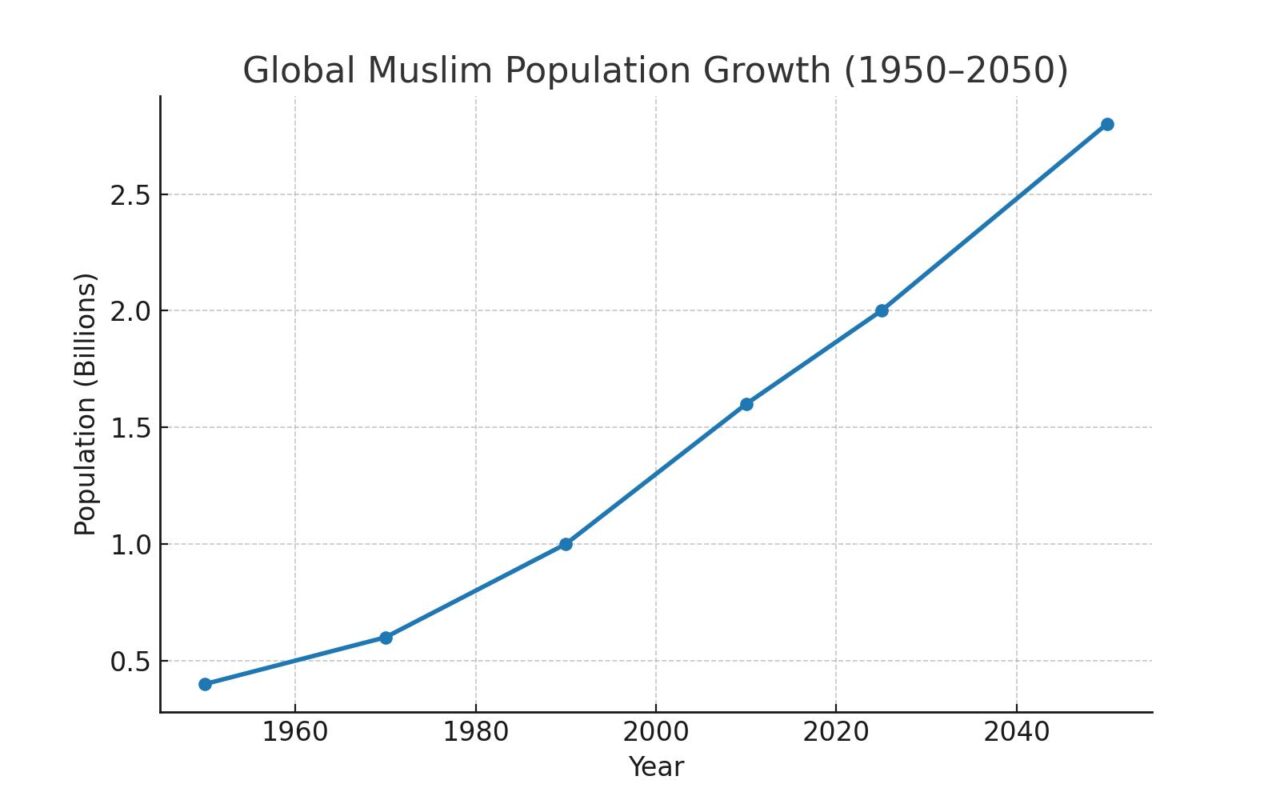Religion is one of the strongest forces shaping societies, cultures, and global interactions. Among the world’s major faiths, Islam stands out as one of the fastest-growing religions. Every year, researchers and organizations release new statistics to track this growth, which sparks a common question: How Many Muslims in the World?
How Many Muslims in the World? In 2025, the global Muslim population will have crossed a significant milestone, reaching over 2 billion people. This article explores not only the numbers but also the history, regional distribution, cultural influence, and future projections of the Muslim population.
“Islam is not just a religion but a global community that spans every corner of the world.”
Introduction to the Global Muslim Population
When exploring How Many Muslims in the World, it is important to look beyond statistics and understand the context. With more than one-fourth of humanity identifying as Muslim, Islam is the second-largest religion after Christianity. The presence of Muslims spans from Asia and Africa to Europe, the Americas, and Oceania, influencing global politics, economics, and culture. You can also What is the difference between Islam and Muslims?
Global Estimate of Muslims in 2025
According to data from organizations like Pew Research Center, Muslims in 2025 account for around 25% of the global population. This means that one out of every four people in the world is a Muslim.
🌍 Table: Muslim Population Distribution by Continent (2025)
| Continent | Estimated Muslim Population | Share of Global Muslims | Notable Countries |
|---|---|---|---|
| Asia | 1.4 billion+ | ~65% | Indonesia, Pakistan, India, Bangladesh |
| Africa | 600 million+ | ~30% | Nigeria, Egypt, Sudan, Algeria |
| Europe | 50 million+ | ~2.5% | France, Germany, UK, Russia |
| North America | 6 million+ | <1% | USA, Canada |
| South America | 5 million+ | <1% | Brazil, Argentina |
| Oceania | 1 million+ | <1% | Australia, New Zealand |
This breakdown shows how Asia and Africa dominate in numbers, making them the central hubs of Islam worldwide.
Historical Context: How Did the Muslim Population Grow?
The story of Islam’s population growth begins in the 7th century in Arabia. From a small community in Makkah and Madinah, Islam spread rapidly through trade, migration, and conquests. Within a century, it reached Africa, Europe, and Asia.
- Medieval Era: Islam thrived in the Middle East, North Africa, and parts of Europe (Spain, Balkans).
- Colonial Period: Migration patterns carried Muslims to new continents.
- Modern Era: Globalization and migration expanded Islam into Europe, North America, and beyond.
Today’s 2 billion Muslims are the result of centuries of expansion, resilience, and cultural integration. You can also learn how to be a true muslim.
Countries With the Largest Muslim Populations
Five countries together make up almost half of the world’s Muslims:
- Indonesia – Over 240 million Muslims, the largest Muslim population in the world.
- Pakistan – Around 230 million Muslims.
- India – Nearly 200 million Muslims, the largest minority group in the country.
- Bangladesh – About 160 million Muslims.
- Nigeria – Over 110 million Muslims, leading Africa’s Muslim population.
Other significant Muslim-majority countries include Egypt, Turkey, Iran, Saudi Arabia, and Algeria.
Regional Insights
Asia: The Heart of Islam
Asia alone hosts nearly two-thirds of Muslims. With countries like Indonesia, Pakistan, and Bangladesh leading, Islam’s roots in Asia are deep and vibrant. India, though not a Muslim-majority country, is home to one of the world’s largest Muslim minorities.
Africa: Rapid Growth and Diversity
Africa’s Muslim population is diverse, with North Africa being almost entirely Muslim, while Sub-Saharan Africa has countries like Nigeria and Sudan where Islam grows alongside Christianity. Fertility rates remain high, ensuring continued growth.
Europe: A Growing Minority
Muslims make up around 5% of Europe’s population, concentrated in France, Germany, the UK, and Russia. Migration, refugee movements, and second-generation European Muslims are shaping the continent’s future.
Americas: Small but Influential
- North America has over 6 million Muslims, mainly in the USA and Canada. They play an important role in politics, business, and academia.
- South America has about 5 million Muslims, with Brazil and Argentina hosting notable communities.
Oceania: Emerging Presence
Australia and New Zealand together host over a million Muslims. Although small in numbers, they have a strong influence on culture and interfaith dialogue.
Growth of the Muslim Population
The Muslim population is not just large—it’s growing faster than most other religions. Key factors include:
- High Fertility Rates: Muslim-majority nations tend to have higher birth rates.
- Young Population: With a median age younger than the global average, Muslims represent a youthful demographic.
- Conversions: Islam continues to attract converts, particularly in Europe and the US.
- Migration: Patterns of global migration have boosted Muslim populations in the West.
Cultural and Economic Influence
Understanding How Many Muslims in the World goes hand in hand with recognizing their global influence:
- Cultural Impact: From food (halal cuisine) to fashion (modest wear), Muslims shape global trends.
- Economy: Muslim-majority countries dominate in energy (oil, gas) and have booming markets in finance (Islamic banking).
- Innovation: Growing participation in science, tech, and education highlights Muslim contributions worldwide.
“The strength of Islam lies not only in numbers but in the vibrancy of its communities.”
Future Projections
The global Muslim population is set to continue its upward trajectory:
- By 2050, Muslims may nearly equal the number of Christians worldwide.
- By 2100, Islam could become the largest religion globally, depending on fertility and migration patterns.
This means Islam will remain at the heart of discussions on geopolitics, culture, and economics throughout the 21st century.
Visualizing Muslim Growth
Demographic studies often use graphs to illustrate growth. A line graph of the Muslim population (1950–2050) would show:

- 1950: ~500 million Muslims.
- 2000: ~1.2 billion Muslims.
- 2025: ~2 billion Muslims.
- 2050: ~3 billion Muslims (projected).
The sharp upward trend reflects Islam’s steady rise as a global force.
FAQs
Which countries have the largest Muslim populations in 2025?
The top five countries are Indonesia, Pakistan, India, Bangladesh, and Nigeria. Together, they host nearly half of the world’s Muslims, with Indonesia leading at over 240 million followers.
What factors contribute to the growth of the Muslim population?
High fertility rates, a young demographic, migration, and global conversions are the main drivers. Muslim-majority countries have younger populations, ensuring continuous growth compared to other religious groups worldwide.
How is the Muslim population distributed across continents in 2025?
Asia holds the majority with about 1.4 billion Muslims, followed by Africa with 600 million. Europe has around 50 million, while the Americas and Oceania together account for less than 2%.
What are the future projections for the Muslim population?
By 2050, Muslims are expected to nearly equal Christians in number. If trends continue, Islam may become the largest religion by the century’s end due to migration, high birth rates, and conversions.
Conclusion
So, How Many Muslims in the World in 2025? The answer is more than 2 billion people, nearly one in four humans. Spread across continents, Muslims form a diverse and dynamic community that influences culture, economics, and politics.
With their youthful population, strong traditions, and rising global presence, Muslims will continue to play a key role in shaping the future of humanity.
Final Thought: How Many Muslims in the World? Understanding the Muslim population is not just about numbers. It is about appreciating the diversity, history, and significance of one of the world’s largest and most influential communities.




